Shuai Liu
STRATA-TS: Selective Knowledge Transfer for Urban Time Series Forecasting with Retrieval-Guided Reasoning
Aug 26, 2025Abstract:Urban forecasting models often face a severe data imbalance problem: only a few cities have dense, long-span records, while many others expose short or incomplete histories. Direct transfer from data-rich to data-scarce cities is unreliable because only a limited subset of source patterns truly benefits the target domain, whereas indiscriminate transfer risks introducing noise and negative transfer. We present STRATA-TS (Selective TRAnsfer via TArget-aware retrieval for Time Series), a framework that combines domain-adapted retrieval with reasoning-capable large models to improve forecasting in scarce data regimes. STRATA-TS employs a patch-based temporal encoder to identify source subsequences that are semantically and dynamically aligned with the target query. These retrieved exemplars are then injected into a retrieval-guided reasoning stage, where an LLM performs structured inference over target inputs and retrieved support. To enable efficient deployment, we distill the reasoning process into a compact open model via supervised fine-tuning. Extensive experiments on three parking availability datasets across Singapore, Nottingham, and Glasgow demonstrate that STRATA-TS consistently outperforms strong forecasting and transfer baselines, while providing interpretable knowledge transfer pathways.
Adversarial Video Promotion Against Text-to-Video Retrieval
Aug 12, 2025Abstract:Thanks to the development of cross-modal models, text-to-video retrieval (T2VR) is advancing rapidly, but its robustness remains largely unexamined. Existing attacks against T2VR are designed to push videos away from queries, i.e., suppressing the ranks of videos, while the attacks that pull videos towards selected queries, i.e., promoting the ranks of videos, remain largely unexplored. These attacks can be more impactful as attackers may gain more views/clicks for financial benefits and widespread (mis)information. To this end, we pioneer the first attack against T2VR to promote videos adversarially, dubbed the Video Promotion attack (ViPro). We further propose Modal Refinement (MoRe) to capture the finer-grained, intricate interaction between visual and textual modalities to enhance black-box transferability. Comprehensive experiments cover 2 existing baselines, 3 leading T2VR models, 3 prevailing datasets with over 10k videos, evaluated under 3 scenarios. All experiments are conducted in a multi-target setting to reflect realistic scenarios where attackers seek to promote the video regarding multiple queries simultaneously. We also evaluated our attacks for defences and imperceptibility. Overall, ViPro surpasses other baselines by over $30/10/4\%$ for white/grey/black-box settings on average. Our work highlights an overlooked vulnerability, provides a qualitative analysis on the upper/lower bound of our attacks, and offers insights into potential counterplays. Code will be publicly available at https://github.com/michaeltian108/ViPro.
Spectral Efficiency-Aware Codebook Design for Task-Oriented Semantic Communications
Aug 06, 2025Abstract:Digital task-oriented semantic communication (ToSC) aims to transmit only task-relevant information, significantly reducing communication overhead. Existing ToSC methods typically rely on learned codebooks to encode semantic features and map them to constellation symbols. However, these codebooks are often sparsely activated, resulting in low spectral efficiency and underutilization of channel capacity. This highlights a key challenge: how to design a codebook that not only supports task-specific inference but also approaches the theoretical limits of channel capacity. To address this challenge, we construct a spectral efficiency-aware codebook design framework that explicitly incorporates the codebook activation probability into the optimization process. Beyond maximizing task performance, we introduce the Wasserstein (WS) distance as a regularization metric to minimize the gap between the learned activation distribution and the optimal channel input distribution. Furthermore, we reinterpret WS theory from a generative perspective to align with the semantic nature of ToSC. Combining the above two aspects, we propose a WS-based adaptive hybrid distribution scheme, termed WS-DC, which learns compact, task-driven and channel-aware latent representations. Experimental results demonstrate that WS-DC not only outperforms existing approaches in inference accuracy but also significantly improves codebook efficiency, offering a promising direction toward capacity-approaching semantic communication systems.
D3: Training-Free AI-Generated Video Detection Using Second-Order Features
Aug 01, 2025Abstract:The evolution of video generation techniques, such as Sora, has made it increasingly easy to produce high-fidelity AI-generated videos, raising public concern over the dissemination of synthetic content. However, existing detection methodologies remain limited by their insufficient exploration of temporal artifacts in synthetic videos. To bridge this gap, we establish a theoretical framework through second-order dynamical analysis under Newtonian mechanics, subsequently extending the Second-order Central Difference features tailored for temporal artifact detection. Building on this theoretical foundation, we reveal a fundamental divergence in second-order feature distributions between real and AI-generated videos. Concretely, we propose Detection by Difference of Differences (D3), a novel training-free detection method that leverages the above second-order temporal discrepancies. We validate the superiority of our D3 on 4 open-source datasets (Gen-Video, VideoPhy, EvalCrafter, VidProM), 40 subsets in total. For example, on GenVideo, D3 outperforms the previous best method by 10.39% (absolute) mean Average Precision. Additional experiments on time cost and post-processing operations demonstrate D3's exceptional computational efficiency and strong robust performance. Our code is available at https://github.com/Zig-HS/D3.
Mixture-of-Experts for Personalized and Semantic-Aware Next Location Prediction
May 30, 2025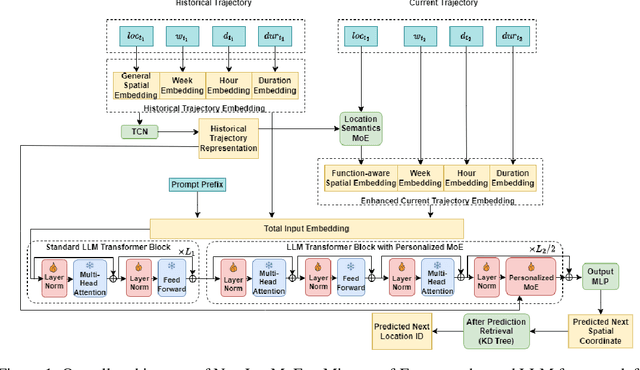
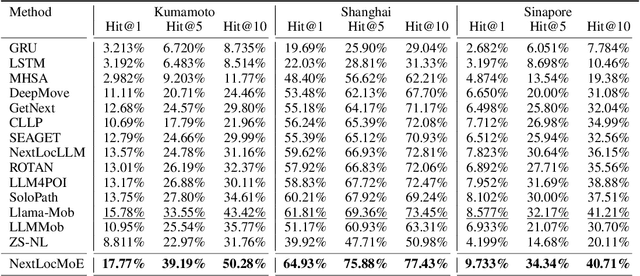
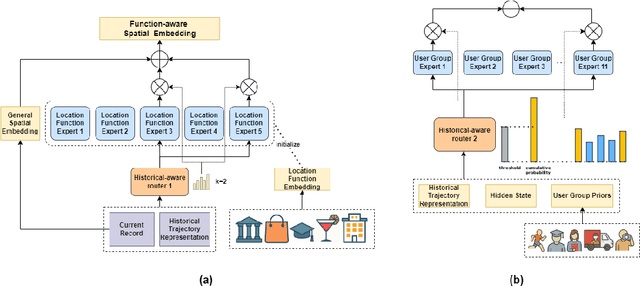

Abstract:Next location prediction plays a critical role in understanding human mobility patterns. However, existing approaches face two core limitations: (1) they fall short in capturing the complex, multi-functional semantics of real-world locations; and (2) they lack the capacity to model heterogeneous behavioral dynamics across diverse user groups. To tackle these challenges, we introduce NextLocMoE, a novel framework built upon large language models (LLMs) and structured around a dual-level Mixture-of-Experts (MoE) design. Our architecture comprises two specialized modules: a Location Semantics MoE that operates at the embedding level to encode rich functional semantics of locations, and a Personalized MoE embedded within the Transformer backbone to dynamically adapt to individual user mobility patterns. In addition, we incorporate a history-aware routing mechanism that leverages long-term trajectory data to enhance expert selection and ensure prediction stability. Empirical evaluations across several real-world urban datasets show that NextLocMoE achieves superior performance in terms of predictive accuracy, cross-domain generalization, and interpretability
Enhancing Efficiency and Exploration in Reinforcement Learning for LLMs
May 24, 2025Abstract:Reasoning large language models (LLMs) excel in complex tasks, which has drawn significant attention to reinforcement learning (RL) for LLMs. However, existing approaches allocate an equal number of rollouts to all questions during the RL process, which is inefficient. This inefficiency stems from the fact that training on simple questions yields limited gains, whereas more rollouts are needed for challenging questions to sample correct answers. Furthermore, while RL improves response precision, it limits the model's exploration ability, potentially resulting in a performance cap below that of the base model prior to RL. To address these issues, we propose a mechanism for dynamically allocating rollout budgets based on the difficulty of the problems, enabling more efficient RL training. Additionally, we introduce an adaptive dynamic temperature adjustment strategy to maintain the entropy at a stable level, thereby encouraging sufficient exploration. This enables LLMs to improve response precision while preserving their exploratory ability to uncover potential correct pathways. The code and data is available on: https://github.com/LiaoMengqi/E3-RL4LLMs
XY-Cut++: Advanced Layout Ordering via Hierarchical Mask Mechanism on a Novel Benchmark
Apr 14, 2025Abstract:Document Reading Order Recovery is a fundamental task in document image understanding, playing a pivotal role in enhancing Retrieval-Augmented Generation (RAG) and serving as a critical preprocessing step for large language models (LLMs). Existing methods often struggle with complex layouts(e.g., multi-column newspapers), high-overhead interactions between cross-modal elements (visual regions and textual semantics), and a lack of robust evaluation benchmarks. We introduce XY-Cut++, an advanced layout ordering method that integrates pre-mask processing, multi-granularity segmentation, and cross-modal matching to address these challenges. Our method significantly enhances layout ordering accuracy compared to traditional XY-Cut techniques. Specifically, XY-Cut++ achieves state-of-the-art performance (98.8 BLEU overall) while maintaining simplicity and efficiency. It outperforms existing baselines by up to 24\% and demonstrates consistent accuracy across simple and complex layouts on the newly introduced DocBench-100 dataset. This advancement establishes a reliable foundation for document structure recovery, setting a new standard for layout ordering tasks and facilitating more effective RAG and LLM preprocessing.
Content-Distortion High-Order Interaction for Blind Image Quality Assessment
Apr 07, 2025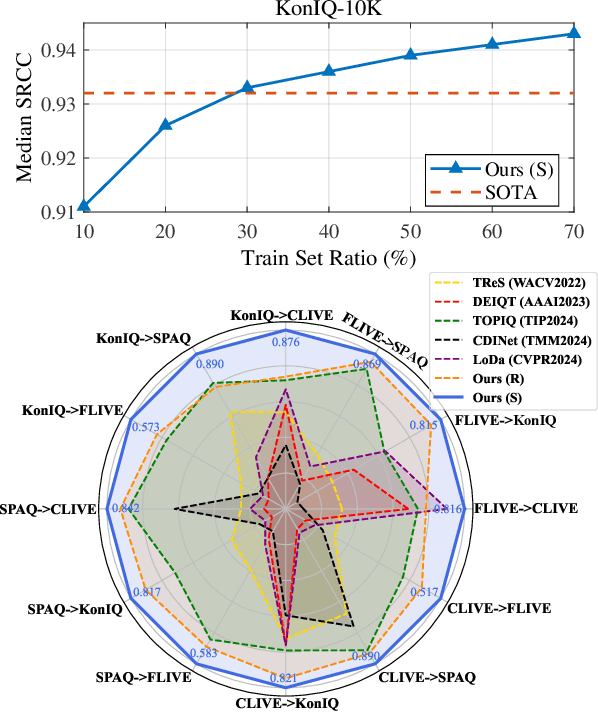
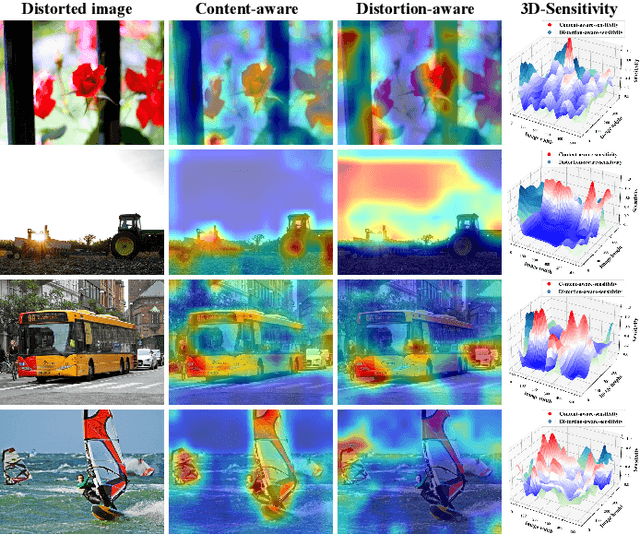
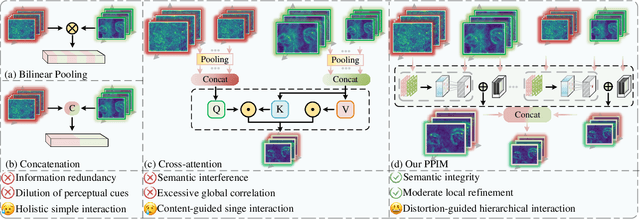

Abstract:The content and distortion are widely recognized as the two primary factors affecting the visual quality of an image. While existing No-Reference Image Quality Assessment (NR-IQA) methods have modeled these factors, they fail to capture the complex interactions between content and distortions. This shortfall impairs their ability to accurately perceive quality. To confront this, we analyze the key properties required for interaction modeling and propose a robust NR-IQA approach termed CoDI-IQA (Content-Distortion high-order Interaction for NR-IQA), which aggregates local distortion and global content features within a hierarchical interaction framework. Specifically, a Progressive Perception Interaction Module (PPIM) is proposed to explicitly simulate how content and distortions independently and jointly influence image quality. By integrating internal interaction, coarse interaction, and fine interaction, it achieves high-order interaction modeling that allows the model to properly represent the underlying interaction patterns. To ensure sufficient interaction, multiple PPIMs are employed to hierarchically fuse multi-level content and distortion features at different granularities. We also tailor a training strategy suited for CoDI-IQA to maintain interaction stability. Extensive experiments demonstrate that the proposed method notably outperforms the state-of-the-art methods in terms of prediction accuracy, data efficiency, and generalization ability.
EgoLife: Towards Egocentric Life Assistant
Mar 05, 2025Abstract:We introduce EgoLife, a project to develop an egocentric life assistant that accompanies and enhances personal efficiency through AI-powered wearable glasses. To lay the foundation for this assistant, we conducted a comprehensive data collection study where six participants lived together for one week, continuously recording their daily activities - including discussions, shopping, cooking, socializing, and entertainment - using AI glasses for multimodal egocentric video capture, along with synchronized third-person-view video references. This effort resulted in the EgoLife Dataset, a comprehensive 300-hour egocentric, interpersonal, multiview, and multimodal daily life dataset with intensive annotation. Leveraging this dataset, we introduce EgoLifeQA, a suite of long-context, life-oriented question-answering tasks designed to provide meaningful assistance in daily life by addressing practical questions such as recalling past relevant events, monitoring health habits, and offering personalized recommendations. To address the key technical challenges of (1) developing robust visual-audio models for egocentric data, (2) enabling identity recognition, and (3) facilitating long-context question answering over extensive temporal information, we introduce EgoButler, an integrated system comprising EgoGPT and EgoRAG. EgoGPT is an omni-modal model trained on egocentric datasets, achieving state-of-the-art performance on egocentric video understanding. EgoRAG is a retrieval-based component that supports answering ultra-long-context questions. Our experimental studies verify their working mechanisms and reveal critical factors and bottlenecks, guiding future improvements. By releasing our datasets, models, and benchmarks, we aim to stimulate further research in egocentric AI assistants.
Efficient 4D Gaussian Stream with Low Rank Adaptation
Feb 23, 2025Abstract:Recent methods have made significant progress in synthesizing novel views with long video sequences. This paper proposes a highly scalable method for dynamic novel view synthesis with continual learning. We leverage the 3D Gaussians to represent the scene and a low-rank adaptation-based deformation model to capture the dynamic scene changes. Our method continuously reconstructs the dynamics with chunks of video frames, reduces the streaming bandwidth by $90\%$ while maintaining high rendering quality comparable to the off-line SOTA methods.
 Add to Chrome
Add to Chrome Add to Firefox
Add to Firefox Add to Edge
Add to Edge